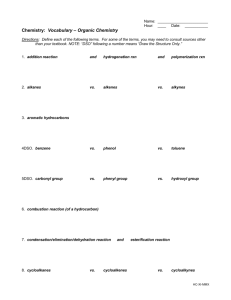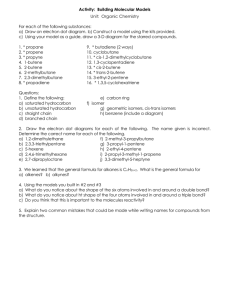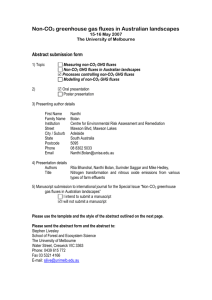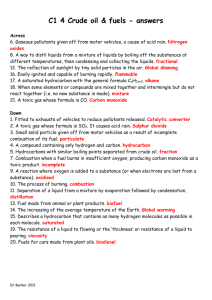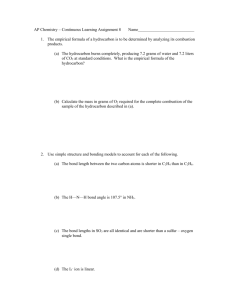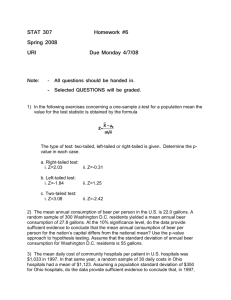Bacterial Enumeration
advertisement
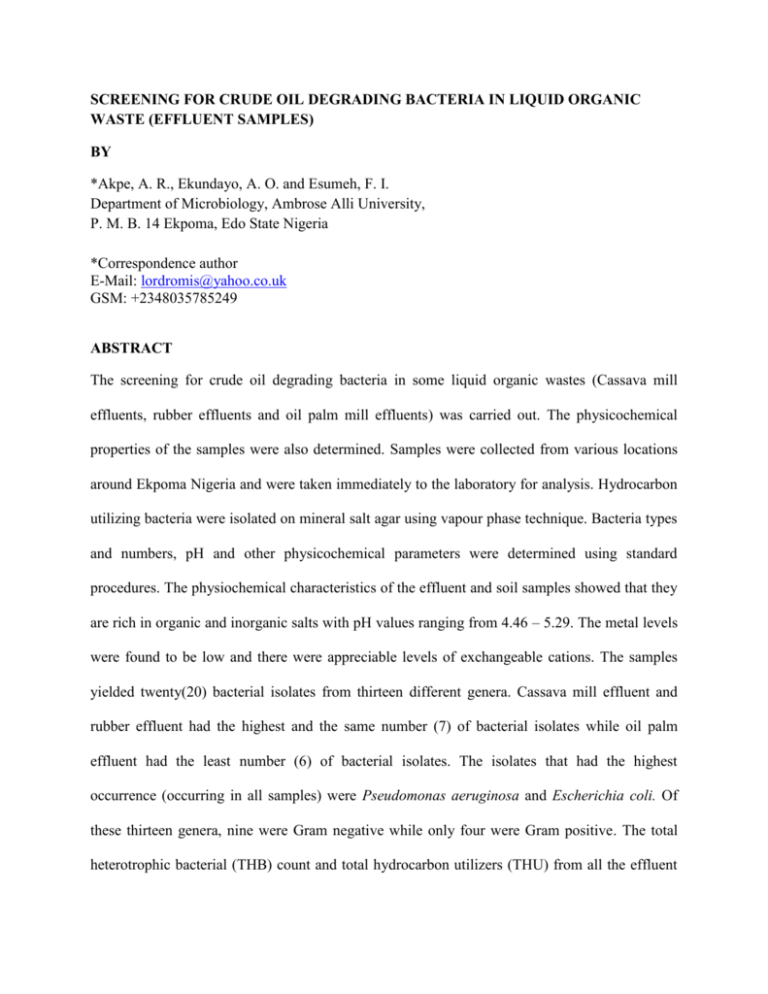
SCREENING FOR CRUDE OIL DEGRADING BACTERIA IN LIQUID ORGANIC WASTE (EFFLUENT SAMPLES) BY *Akpe, A. R., Ekundayo, A. O. and Esumeh, F. I. Department of Microbiology, Ambrose Alli University, P. M. B. 14 Ekpoma, Edo State Nigeria *Correspondence author E-Mail: lordromis@yahoo.co.uk GSM: +2348035785249 ABSTRACT The screening for crude oil degrading bacteria in some liquid organic wastes (Cassava mill effluents, rubber effluents and oil palm mill effluents) was carried out. The physicochemical properties of the samples were also determined. Samples were collected from various locations around Ekpoma Nigeria and were taken immediately to the laboratory for analysis. Hydrocarbon utilizing bacteria were isolated on mineral salt agar using vapour phase technique. Bacteria types and numbers, pH and other physicochemical parameters were determined using standard procedures. The physiochemical characteristics of the effluent and soil samples showed that they are rich in organic and inorganic salts with pH values ranging from 4.46 – 5.29. The metal levels were found to be low and there were appreciable levels of exchangeable cations. The samples yielded twenty(20) bacterial isolates from thirteen different genera. Cassava mill effluent and rubber effluent had the highest and the same number (7) of bacterial isolates while oil palm effluent had the least number (6) of bacterial isolates. The isolates that had the highest occurrence (occurring in all samples) were Pseudomonas aeruginosa and Escherichia coli. Of these thirteen genera, nine were Gram negative while only four were Gram positive. The total heterotrophic bacterial (THB) count and total hydrocarbon utilizers (THU) from all the effluent samples ranged from 3.0 x 104 to 6.0 x 107 cfu/ml and 2.3x102 to 4.2 x 103cfu/ml respectively. The counts of hydrocarbon utilizers were obviously lower than the heterotrophic counts, although the differences in counts were found to be statistically non-significant (P > 0.05).Rubber effluents and oil palm mill effluents had the highest number of hydrocarbon utilizers with three isolates each. The active hydrocarbon utilizers encountered in this study includes Serratiamarscescens, Bacillus cereus, Pseudomonas aeruginosa, Enterobacter aerogenes and Bacillus subtilis. The presence of nutrients and crudeoildegradingbacteria in these effluents suggeststhatthese effluents canbeused to enhancebioremediationthroughtheir use as biostimulation and bioaugmentation agents. Key words : bacteria, effluents, crude oil, degrading, physicochemical Short Running Title : Crude oil degrading bacteria INTRODUCTION The global increase in petroleum exploration, production and usage has resulted to increased discharge of products and operational materials into the environment (Mandri and Lin, 2007). Environmental (air, soil and fresh water) pollutionby petroleum and petrochemical products has attracted much attention in recent decades. This is because most of these product especially the polycyclic aromatic hydrocarbons (PAHs) are toxic, mutagenic and carcinogenic(Clementeet al., 2001). Prolonged exposure to high concentration may cause the development of liver or kidney disease, possible damage to the bone marrow and an increased risk of cancer (Mishra et al., 2001). In addition, PAHs have a widespread occurrence in various ecosystems that contribute to the persistence of these compounds in the environment.Crude oil pollution of soil and surface water have been prevalent in Nigeria and other oil producing countries since the commencement of soil exploration and development petroleum industry (Ifeadi and Nwankwo 1987; Okoh et al., 2001). Of the many remediation methods currently in use or under development, bioremediation is viewed as one of the most promising technologies. The microbial by-product of oil biodegradation becomes part of the natural food chain with much of the degraded hydrocarbon material further metabolized by marine organism or incorporated in soil humus with accumulation to toxic materials in the environment (Shoemaker, 1989; Ijah et al., 2003a). Lack of essential nutrients such as nitrogen and phosphorus is one of the major factors affecting biodegradation of hydrocarbon by microorganism in soil and water environment. Therefore the addition of organic or inorganic nitrogen-rich nutrients (biostimulation) is an effective approach to enhance bioremediation process (Walworth et al., 2007). Positive effects of nitrogen amendments on degradation have been widely demonstrated (Abioyeet al., 2009). Some liquid organic waste such as cassava mill effluents, oil palm mill effluents and rubber effluents have diverse chemical composition and some of the constituents may be deleterious to microbial growth. This current study seeks other approaches to bioremediation byscreening for the presence of crude oil degrading bacteria in these effluent samples and the physicochemical properties of the samples. This will determine their possible use to enhance bioremediation. MATERIALS AND METHODS Sourcesof Samples, Media used and Sterilization procedures Ten (10)Samples each of cassava mill effluents, rubber effluents, oil palm mill effluents were collected from various locations in Ekpoma, Edo State - Nigeria. The crude oil used was Chevron Escravos crude oil obtained from chevron tank farm at Escravos. The mineral salt medium used was that previously described by Mills et al. (1978) and modified by Okpokwasili and Amanchukwu (1988). Bacteriological agar (oxoid) was added to obtain a solid medium at a rate of 1.5% (%) when necessary. The general purpose media used include commercial preparations of Oxoid nutrient agar, nutrient broth, MacConkey agar, peptone water, urease agar and citrate agar. Except otherwise stated, media were sterilized by autoclaving at 121oC for 15 minutes. Crude oil used for biodegradation studies were filter -sterilized using sterile 0.22µm pore size membrane (Type: MILLEX-GS Millipore Corporation, Bedford, MA01730 Rev. 9/94 12172). This method was adopted since petroleum contains volatile components which evaporate if sterilized by autoclaving. In addition, crude oil naturally contains hydrocarbon utilizing microorganisms which if autoclaved, will be killed releasing their carbon nutrient into the medium. These organic compounds from the organisms might be preferred by the experimental microorganisms for growth and as a result, produce false positive result on the utilization of petroleum hydrocarbon. Glass wares were sterilized at 160oC for one hour using hot air oven. Determination of Total Heterotrophic and Total Hydrocarbon Utilizing Bacterial numbers and types Bacterial Enumeration The total heterotrophic bacterial count in the samples were determined by making tenfold serial dilution of the samples on normal saline (0.85% w/v sterile sodium chloride). Then 1ml of the appropriate dilution was pour plated in duplicates on the surface of the appropriate medium. The plates were then incubated for between 24-48 hours at a temperature of 37oC, following incubation the colonies that developed on the plates were counted. Also, Mineral Salt Agar medium of Mill et al. (1978) as modified by Okpokwasili and Amanchukwu (1988) was used for the enumeration of hydrocarbon utilizing bacteria. Chevron Escravos crude oil soaked in sterile 9cm Whatman (No.1) filter paper and placed in dish cover served as carbon source. Thus the hydrocarbon was supplied to the inoculum by vapour-phase transfer. After incubation at room temperature for 1-5days, colony counts were taken and recorded. Bacterial Characterization and Identification The biochemical and phenotypic characteristics used to characterize and identify isolates include Gram staining, colonial appearance, motility, urease, catalase, indole, oxidase, citrate, methyl red, voges proskaeur and sugar fermentation. These tests were performed using the methods of Gerhardt (1994); Harley and Prescott (2002) and identified based on Barrow and Feltham (1986) and Holt (1994). Determination of Physicochemical Properties of Samples Methods for the determination of physicochemical properties of samples (cassava mill effluents, oil palm mill effluents and rubber effluents) were as outlined in Standard Methods for the Examination of water and wastewater (APHA, 1985). The pH meter used was pocket-sized HANA pHep+ HI 98108 with automatic temperature compensation. Conductivity values were determined using conductivity meter Jenway 4010 UK and temperatures were measured using standard mercury thermometer. Total organic carbon was determined by dichromate wet oxidation methods of Walkley and Black as modified by Dhyan et al. (1999). Nitrate content was determined using the macro Kjeldahl digestion method of Brady and Weil (1999). Available phosphorus was determined using the method reported by Olsen and Sommers (1982). Sulphate was determined using the turbidometric method while oil and grease was determined by the partition gravimetric method. Sodium and potassium were determined using flame photometric method while calcium and magnesium were determined using the method of Brady and Weil (1999). The metal contents were determined using an Atomic Absorption Spectrophotometer (AAS) (Perkin Elmer AA Unit Model: 3100 Serial Number: 148157) RESULTS AND DISCUSSION The bacterial isolates from the various samples (Table 1) showed that 20 isolates from 13 different genera were obtained in this study. Cassava mill effluents and rubber effluentshad the highest andsame number (7) of bacterial isolates while oil palm mill effluents had the least number (6) of bacterial isolates. The isolates that had the highest occurrence (occurring in all samples) werePseudomonas aeruginosaand Escherichia coli. The presence of these different genera of bacteria from these samples aligns with the widely documented fact that bacteria are present in almost any ecological niche (Harley and Prescott, 2002). Of these thirteen genera, nine were Gram negative while only four were Gram positive. The preponderance of Gram negative bacteria in this study is similar to the earlier report of Foght and Westlake (1987) that both Gram positive and Gram negative bacteria are encountered in the degradation of contaminants with Gram negative bacteria dominating. This finding also correlates the work of Agbonlahor et al. (1993) and Esumeh et al. (2009) that isolated only Gram negative organisms suggesting that they are better degraders of crude oil compared with their Gram positive counterparts. One of the most predominant isolate in this study - Pseudomonas spp has been noted for its biochemical versatility with the ability to grow on diverse substrates and chemicals (Devereux and Sizemore, 1982; Chikere and Chijioke-Osuji (2006). Some of the isolates obtained in this present study were encountered by Akpe (2003); Chikere and Chijioke-Osuji (2006); Ekundayo et al. (2009), Esumeh et al. (2009) and Ogbulie et al. (2010). Table 2 showed a list of hydrocarbon utilizing bacteria from the various samples. Rubber effluents and oil palm mill effluents had the highest number of hydrocarbon utilizers with three isolates each. The active hydrocarbon utilizers encountered in this study includes Serratiamarscescens, Bacillus cereus, Pseudomonas aeruginosa, Enterobacter aerogenes and Bacillus subtilis. The hydrocarbon utilizing genera encountered in this study have been reported earlier. Pseudomonas spp are often isolated from hydrocarbon contaminated sites. They have broad activity for hydrocarbons and can degrade many alkanes, alicyclics and aromatics. Utilization of hydrocarbon - based substrate has also been reported of species of Staphylococcus, Aeromonas, Proteus, Corynebacterium, Streptococcus, Bacillus, Micrococcus, and Alcaligenes (Hughes et al. 1984; Benka – Cooker and Olumagin, 1999; Plohl et al., 2002; Iyagba et al, 2008). The total heterotrophic bacterial (THB) count and total hydrocarbon utilizers (THU) from all the effluent samples ranged from 3.0 x 104 to 6.0 x 107 cfu/ml and 2.3x102 to 4.2 x 103cfu/ml respectively (Table 3). The counts of hydrocarbon utilizers were obviously lower than the heterotrophic counts, although the differences in counts were found to be statistically nonsignificant (P > 0.05). This result was found to be similar with that earlier reported by Okpokwasili and Oton (2006); Eziuzor and Okpokwasili (2009). The lower number of hydrocarbon utilizers compared to the heterotrophic population suggested that not all organisms that can cause the decay of biological substrates could degrade crude oil (Atlas and Bartha, 1993). Also, crude oil contains some fractions that may greatly affect the survival of other microorganisms because hydrocarbons are known to contain volatile toxic components which can inhibit growth (Obire, 1993). It is only crude oil degraders that can easily adapt to such changes. However, in a previous study of crude oil polluted and unpolluted soil samples by Chikere and Chijioke – Osuji (2006), it was found that hydrocarbon utilizers’ population were higher than the heterotrophs. The physicochemical properties of the samples are shown in Table 4. It was observed that the pH of samples ranged from acidic range of 4.46 to near neutrality 5.29. The most acidic sample was cassava mill effluent (pH 4.46) while the least acidic is rubber effluent (pH 5.29). The high acidity of cassava mill effluent is not unconnected with the fermentative activities of microorganisms on the sugars and starch in the effluent. The conductivity values ranged from 0.04 mscm-1 to 7.12 mscm-1 with rubber effluent having the least and cassava mill effluent having the highest. The metal level was found to be low and in some cases not detected. The metal contents of samples are below reported pollution levels (Chen et al., 1998; Ayidinalp and Cresser, 2003; Nweke et al., 2006). Hence samples were not considered metal-polluted. Nitrate level was highest in cassava mill effluents (45 mg/ml) and was lowest in rubber effluents (0.80 mg/ml). The potassium level ranged from 7.99 mg/g in rubber effluent samples to 29.40 mg/ml in cassava mill effluents. Magnesium was highest in rubber effluent (9.15 mg/ml) and lowest in oil palm mill effluent (4.15 mg/g). Among the effluent samples, oil palm mill effluents had the highest content of iron (28.70 mg/ml) followed by cassava mill effluents (13.21 mg/ml), the least iron content was recorded in rubber effluent (0.80 mg/ml). The presence of nitrate, potassium and other inorganic salts and elements in the effluents explains why bacteria could grow in them and suggests the possible role of these effluents in biostimulation and bioaugumentation of crude oil contaminated soil. Also the application of these effluents in these regards will help to solve waste disposal problems in the environment. Treatment of oil polluted soil is necessary to protect water supplies, human health and environmental quality (Chang et al., 1996).Hence the use of these effluents as amendments in crude oil polluted sites is recommended to facilitate bioremediation. Table 1: Bacterial Isolates from Effluent samples Cassava mill effluent Rubber Effluent Oil Palm MillEffluent Klebsiella pneumoniae Pseudomonas aeruginosa Serratia marscescens Lactobacillus spp Streptococcus faecalis, Escherichia coli Pseudomonas aeruginosa Bacillus cereus Bacillus subtilis Staphylococcus aureus Escherichia coli Alcaligenes faecalis Pseudomonas aeruginosa Achromobacter spp Staphylococcus aureus Escherichia coli Proteus mirabilis Acinetobacter spp Enterobacter aerogenes Staphylococcus Saprophyticus Table 2: Hydrocarbon Utilizing Bacteria from the Various Samples Using Vapour Phase Technique Samples Hydrocarbon Utilizer Oil palm mill effluent *Serratiamarscescens, Escherichia coli, *Bacillus cereus, *Pseudomonas aeruginosa Rubber effluent *Pseudomonas aeruginosa, Streptococcus faecalis, *Bacillus subtilis Cassava mill effluent Klebsiella pneumoniae, *Enterobacter aerogenes KEY:* Very active crude oil degraders with colonies appearing within 24hours of incubation in mineral salt medium containing crude oil Table 3: Mean Total Heterotrophic and Hydrocarbon Utilizing Bacterial Counts Samples Oil palm mill effluent Average Total Heterotrophic Bacterial Count 3.0 x 104 ± 0.09 cfu/ml Average Total Hydrocarbon Utilizers’ Count 2.3 x 102 ± 0.04 cfu/ml Rubber effluent 6.4 x 105 ± 0.085 cfu/ml 3.4 x 102 ± 0.025 cfu/ml Cassava mill effluent 6.0 x 107 ± 0.035 cfu/ml 4.2 x 103 ± 0.055 cfu/ml P>0.05 Table 4: Physicochemical Properties of Cassava Effluent, Rubber Effluent, Oil Palm Mill Effluent, Crude oil Contaminated Soil and Normal Farm land soil Samples pH Cassava mill effluent (mg/ml) 4.46 Rubber effluent (mg/ml) 5.29 Oil palm mill effluent (mg/ml) 4.70 Conductivity mscm-1 7.12 0.04 1.55 TDS 462.80 28.40 405.50 Nitrate 45.00 0.80 NT Total Nitrogen NT NT 76560.00 Nitrite 15.00 NT NT Sulphate 45.00 3.40 NT Hardness 214.00 54.80 NT Calcium 75.75 4.92 48.90 Magnesium 6.08 9.15 4.15 Potassium 29.40 7.99 25.20 Sodium 650.00 2.46 5.10 Chromium 0.01 NT ND Manganese 6.57 NT 2.20 Iron 13.21 0.80 28.70 Nickel 0.02 NT ND Zinc 0.53 1.50 0.30 Copper 2.77 NT 0.86 Lead 0.10 ND ND Cadmium 0.01 ND ND Alkalinity NT 48.50 NT Oil and Grease NT NT 3800.00 Phosphorus NT NT 162.00 Parameters Key: ND = Not Detected; NT = Not Tested; TDS = Total Dissolved Solids REFERENCES Abioye, O. P., Alonge, O. A. and Ijah, U. J. J. (2009). Biodegradation of crude oil in soil amended with melon shell. Au. J. T 13 (1): 34-38 Agbonlahor, D. E., Akomeah., P. A., Mensah., J. K., Esumeh, F. I. and A. Ogholaja, (2004). Petroleum hydrocarbon degrading capabilities of microbial isolates from ripe pawpaw fruits. Nig. Ann. Nat. Sci. 5:1-15. Akpe, A. R. (2003). Studies on Biostimulation of crude oil contaminated soil. M.Sc. Thesis, Department of Microbiology, Ambrose Alli University, Ekpoma. American Public Health Association (APHA) (1985). Standard Methods for the enumeration of water and waste. American Public Health Association, 15th editionWashington D.C. Atlas, R. M. and Bartha, R. (1993). Biodegradation. In Microbial Ecology: Fundamentals and Application, 3rd edition. Reading, Ma., Addison-Wesley Publishing Company, Reading, Ma., U.S.A. pp. 129. Aydinalp, C. and Cresser, M.S. (2003): The background level of heavy metals in vertisols under Mediterranean type of climate in the region of Turkey J. Central Europ. Agric. 4(4):289-296. Barrow, G. and Feltham, R. (eds.) (1986). Cowan and Steels Manual for Identification of Medical Bacteria. 3rd Edition. Cambridge University Press Benka–Cooker, M. O. and Olumagin, A. (1995). Waste drilling fluid-utilizing microorganisms in a tropical mangrove swamp oil field location. Bioresource. Technol. 52:211-215. Brady, N. C. and Weil, R. R. (1999). The Nature and Properties of Soils. 12th ed., Prentice Hall Publishers London. Pp 740. Chang, Z., Weaver, R. W. and Rhykerd, R. L. (1996). Oil bioremediation in high and low phosphorus soil. J. Soil Contam. 5: 215-114 Chen, M., Ma, L. Q. and Harris, W. (1998). Background concentration of trace metals in Florida surface soils. Annual Progress Report University of Florida, Gainesville. Chikere, B. O. and Chijioke-Osiji, C. C. (2006). Microbial diversity and physiochemical properties of crude oil-polluted soil. Nig. J. Microbiol. 20(2): 1039-1046. Clemente, A. R., AnazawaT. A. and Durrant, L. R. (2001). Biodegradation of polycyclic aromatic hydrocarbons by soil fungi. Bra. J. Microbiol. 32 (4): 255-261. Devereux, R. and Sizemore, R. K. (1982). Plasmid incidence in marine bacteria isolated from petroleum polluted sites on different petroleum hydrocarbons. Mar. Pollut. Bull. 13: 198-202. Dhyan, S., Chhonkar, P. K. and Pandey, R. N. (1999). Soil, Plant and Water Analysis- A Method Manual. IARI, New Delhi. Ekundayo, A. O., Esumeh, F. I., Akpe, A. R. (2009). Studies on Biostimulation of crude oil contaminated soil. Proceedings of the 1st International Conference, Workshop and exhibition on Biotechnologies for Improved Production of Oil and Gas in the Gulf of Guinea, held in Abuja, Nigeria 1. April 1-3. 2009. BIPOG3-4-35. Pp. 1-6. Esumeh, F. I., Akpe, A. R., Eguagie, O. E. (2009). Crude oil Degrading Capabilities of bacterial isolates from pawpaw (Carica papaya) and sweet orange (Citrus sinensis). A role for plasmid mediated gene. Proceedings of the 1st International Conference, Workshop and exhibition on Biotechnologies for Improved Production of Oil and Gas in the Gulf of Guinea, held in Abuja, Nigeria 1. April 1-3. 2009. BIPOG3-4-34. Pp. 1-7. Eziuzor, S. C. and Okpokwasili, G. C. (2009). Bioremediation of Hydrocarbon contaminated mangrove soil in a bioreactor. Nig.J. Microbiol. 23(1): 1777-1791. Foght, J. M. and Westlake, D. W .S. (1987). Biodegradation of hydrocarbon in fresh waters, In: Vandermuelen, J. H. Hrudy, S. E. (eds.) Oil in Freshwater: Chemistry, Biology, Countermeasure Technology. Pergamon Press, New York. Pp. 252-263. Gerhardt, P. (1994). Methods for Generaland molecular Bacteriology (ed.) ASM Press Washington DC. Harley, J. P. and Prescott, L. M. (2002). Laboratory exercises in Microbiology 5th edn. McGraw Hill Publishers, New York. Holt, J. G. (ed) [1994]. Bergey’s Manual of Determinative Bacteriology 9th Edn. Williams and Wilkins Co., Baltimore Hughes, E. J. L., Bayly, R. C. and Skurray, R. A. (1984). Evidence for iso-functional enzymes in the degradation of phenol, m-and p-toluate, and p-cresol via catechol meta-cleavage pathways in Alcaligenes eutrophus. J. Bacteriol. 158: 79-83. Ifeadi, T. C. and Nwankwo, O. A. (1987): Hydrocarbon mineralization in relation bacterial and fungal contribution. Soil Biol. Biochem. 2: 56-58. Ijah, U. J. J. and Antai, S. P. (2003a). The potential use of Chicken-drop microorganisms for oil spill remediation. The Environmentalist 23: 89-95. Iyagba, M. A., Adoki, A. and Sokari, T. G. (2008). Testing biological methods to treat rubber effluent. Afr. J. Agric. Res. 3(6): 448-454. Mandri, T. and Lin, J. (2007). Isolation and characterization of engine oil degrading indigenous microorganisms in Kwazulu-Natal. Afr. J. Biotech 6 (1): 23-27 Mills, A. L., Brenil, C. and Colwell, R. R. (1978). Enumeration of petroleum degrading marine and estuarine microorganisms by most probable number method. Can. J. of Microbiol. 24: 552-557. Mishra, S., Jyot, J., Kuhad, R. C. and Lal, B. (2001). Evaluation of inoculum addition to stimulate in-situ bioremediation of oily-sludge-contaminated soil. Appl. Environ. Microbiol. 67 (4): 1675-1681. Nweke, C. O., Mgbachi, L. C., Nwangangan, C. and Nwanyanwu, C. E. (2006). Heavy mental tolerance among hydrocarbon utilizing bacteria isolated from oil contaminated soils. Nig. J. Microbiol. 20(2): 1057-1065. Obire, O., (1987). Studies on the development of bacterial inocular to rid the aquatic environment of oil spilled petroleum hydrocarbon. Ph.D. Dissertation presented to the Department of Microbiology University of Benin, Benin City, Nigeria. Ogbulie, T. E., Nwigwe, H. C., Iwuala, M. O. E. and Okpokwasili, G. C. (2010). Study on the use of monoculture and multispecies on bioremediation of crude oil contaminated agricultural soil. Nig. J. Microbiol. 24(1): 2160-2167. Okoh, I. A., Ajisebutu, S., Babalola, G. O. and Trejo-Hermandez, M. R. (2001). A study of the potentials of Burkholderia cepacill strain (RQ1) in the biodegradation of heavy crude oil (Maya). Int. Microbiol. 4: 83-87. Okpokwasili, G. C. and Amanchukwu, S. C. (1988). Petroleum hydrocarbon degradation by Candida spp Environ. Inter. 14: 243-247. Okpokwasili, G. C. and Oton, N. S. (2006): Comparative applications of bioreactors and shake flask systems in the laboratory treatments of oily sludge. Inter. J. Environ. Waste Manag. 1(1): 49-60. Olsen, D. W. and Sommers, L. E. (1982). Determination of total organic carbon. In: Methods of Soil Analysis Part 2 (Chemical and Microbiological Properties) Agronomy Monograph No 9 Pp539-560. Plohl, K., Leskovsek, H., and Bricel, M. (2002). Biological degradation of motor oil in waters. Acta. Chim. Slov. 49: 279-289. Shoemaker, R. C. (1989). Exploitation of indigenous microorganisms for the clean-up of oil spills. Biotechnol Bioeng. 25: 51-52. Walworth, J., Pond, A., Snape, I., Rayner, J., Ferguson, S. and Harvey, P. (2007). Nitrogen requirements for maximizing petroleum bioremediation in a sub Antarctic soil. Cold Reg. Sci Technol. 48 (2): 84-91

